Climate Disasters on the Planet from May 8 to May 14, 2024: Summary
Asia
Afghanistan
Survivors of the catastrophic flood in Afghanistan are still searching for missing loved ones and burying the dead.
On May 10, abnormal rains hit the northern, central, and western parts of the country, causing devastating flash floods and mudslides that resulted in casualties and severe damage. Rescuers pulled people directly from the torrents of mud.
Preliminary data indicate that more than 330 people have died, including 51 children, and over 1,600 people have been injured. The provinces of Baghlan, Takhar, and Badakhshan are the worst hit.
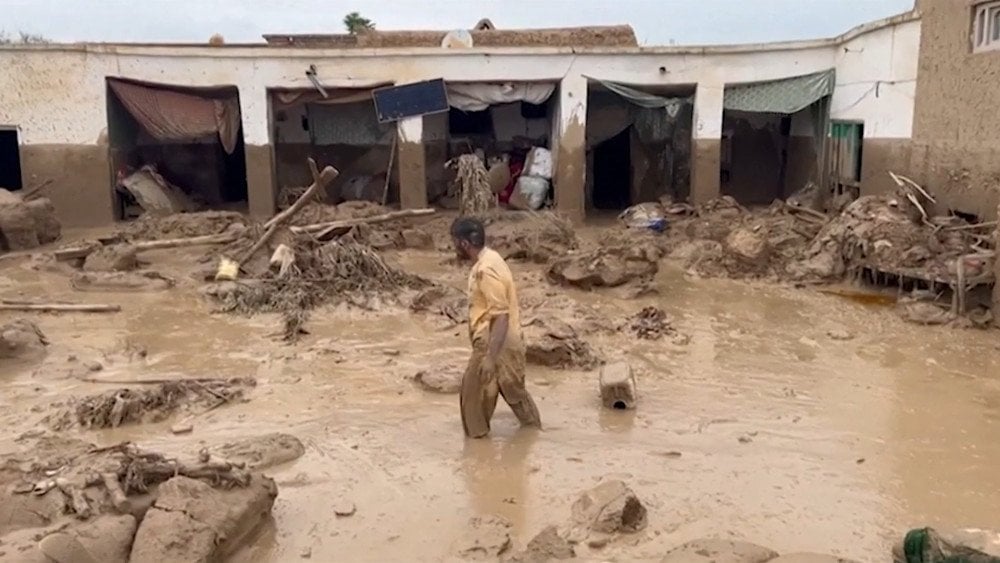
Catastrophic Floods in Afghanistan
The scale of the tragedy is hard to imagine. In Baghlan province alone, about 80,000 people were affected by the natural disaster. 8,000 hectares of farmland were washed away, and 12,000 homes were destroyed.
About 40,000 children were left homeless.
The flood devastated residential areas: streets were covered in mud, more than 1,000 livestock perished. Vital infrastructure, such as water supplies and medical facilities, were damaged.
It is not even possible to deliver humanitarian aid to the affected areas as flows of mud and stones have blocked the roads. Food supplies can only be brought in on pack animals. Local residents are in despair.
“We have no food, no drinking water, no shelter, no blankets, nothing at all, floods have destroyed everything,” said Muhammad Yahqoob, who lost 13 family members, including children. Another resident of Baghlan province said, “People fled to higher ground, seeking refuge in mountains and hills. Unfortunately, some individuals who were unable to leave their homes fell victim to the floodwaters.” He added that survivors are struggling to cope with the situation.
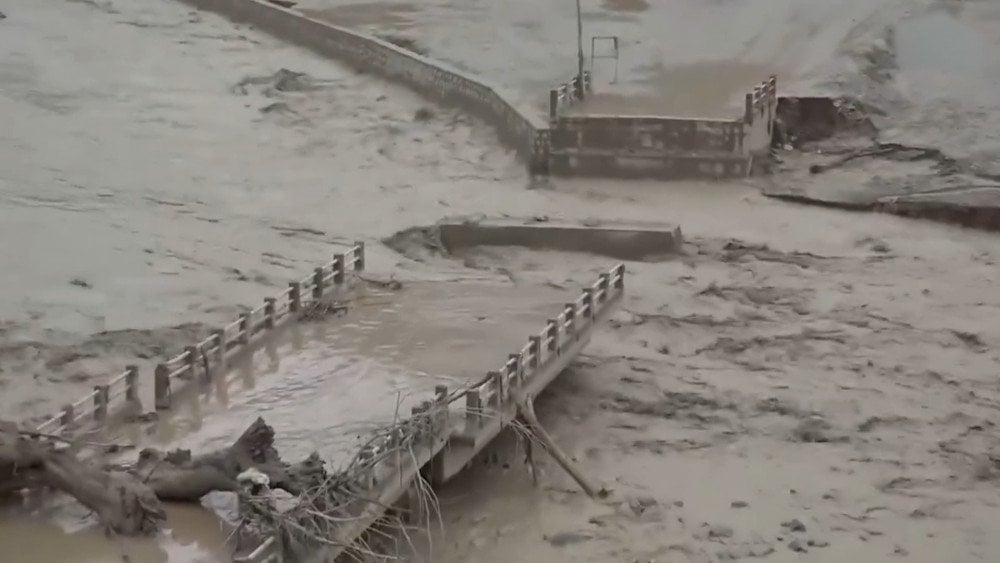
Massive flood damage, Afghanistan
It's important to note that the past winter in Afghanistan was quite dry, which left the soil unable to absorb the amount of rainfall that hit the country in March and continues to this day.
Due to the continuous rains, large areas of farmland are waterlogged.
This is a disaster for the locals since 80% of the country's population relies on agriculture for their subsistence.
India
On May 10, a powerful dust storm swept through the Indian capital, Delhi, killing two people and seriously injuring 23.
The strong winds uprooted trees and knocked down power lines, and caused walls of some buildings to collapse. According to the Meteorological Department, wind speeds in some areas of Delhi reached up to 77 km/h (48 mph).
Adjoining areas including Noida and Ghaziabad also witnessed strong winds, causing traffic disruptions and flight diversion.
On May 13, in the Wadala area of Mumbai, a metal tower collapsed due to strong winds, injuring several people.

A metal tower collapsed due to storm winds, Mumbai, India
In another area of Mumbai, Ghatkopar, a huge 100-foot-tall billboard collapsed onto a petrol station along a busy road due to gusty winds. At the time, more than 100 people were at the gas station, many of whom were trapped under the twisted metal structures.
Rescue operations lasted 18 hours.
The efforts were complicated by the inability to use cutting equipment due to the risk of an explosion at the gas station. Unfortunately, 14 people died, and 74 were injured.

Huge billboard collapsed on a petrol station, Mumbai, India
The storm seriously affected the operation of Mumbai's suburban trains: a support column of the overhead line between Thane and Mulund stations bent due to strong winds. Throughout the day, 170 suburban train services were canceled. The metro service was also suspended between Ari and Andheri East stations after a billboard fell on the contact wire due to strong winds.
Strong winds, sandstorms, and rain hit Gujarat, disrupting daily life across the region.
On May 14, two people were killed by lightning strikes in Gujarat.
In the Chhota Udaipur district, unseasonal rain and hail damaged farmland, jeopardizing future crops. According to the district agriculture specialist, the heavy rain has put nearly 8,000 hectares of summer crops at risk. The sudden rainfall hit several districts, including Botad, Navsari, Bhavnagar, Sabarkantha, and Dangs, with Botad receiving the heaviest downpour of up to 20mm. The stormy weather continued the next day. 249 villages in the state experienced power cuts due to strong winds.
Indonesia
On May 11, record rainfall triggered a disaster in West Sumatra province, Indonesia. Flash floods, landslides, and lahars from Mount Marapi claimed 58 lives, with another 35 missing. 33 people were injured.

Mud mixed with ash covered homes and roads
A lahar is a mudflow consisting of a mixture of water, ash, pumice, and small volcanic rock fragments. It forms on the slopes of a volcano and moves downwards at great speed.
Torrents of mud and ash rushed down the mountain into residential areas, sweeping away everything in their path. 16 bridges and over 100 houses were flooded, while three houses were completely swept away.
As a result of the natural disaster,
over 1,500 families were left homeless.

Aftermath of lahar and massive floods, West Sumatra Province, Indonesia
The disaster affected Agam and Tanah Datar districts and the city of Padang Panjang. Sudden floods also blocked major roads around the Anai Valley waterfall in Tanah Datar district, cutting off access to other cities.
South Korea
In early May, swarms of insects filled the center of Seoul, the capital of South Korea. Oriental mayflies covered the walls and windows of buildings, landing on people and causing discomfort and even fear among city residents.
Scientists link this to the abnormal humidity, heat, and strong winds recently observed in the region. These unusual weather conditions forced the insects to leave their natural habitat by the Han River and move to the city center.

Swarms of Oriental Mayflies Filled the Streets and Buildings, Seoul, South Korea
A representative of the Ministry of Environment said, “Recently, we have been conducting studies on the causes of the large number of oriental mayflies in the capital region and environmentally friendly methods to control their spread.”
North America
USA
On May 10, a severe storm with large hail hit residents of Texas in the USA. In York Creek, Guadalupe County, power lines were downed, three buildings collapsed, and roofs were torn off other houses. At least one person was injured by flying debris. The storm spread to North Texas. Hail and destructive winds were recorded in Denton County. A local resident said that in over 20 years of living in Wimberley, this was the strongest storm she had ever seen.
According to the Texas Division of Emergency Management, seven people were hospitalized with various injuries in Delta County.

Huge Hail in Johnson City, Texas, USA
In Johnson City, ice chunks measuring 15.8 cm (6.25 in) fell from the sky.
Almost every house here had roof damage. The hail punched huge holes in the shingles of houses, through which rainwater poured, flooding people's homes. Some holes were so large that both hands could be placed through them together. In Texas, hail larger than 10 cm is rarely seen.
The size scale of hail from the National Weather Service ends at 11.43 cm (5 in).
Australia
A devastating tornado struck the outskirts of Bunbury, Western Australia.
The funnel was 60 meters wide, and
wind speeds exceeded 150 km/h.
The tornado lasted only four minutes but caused significant destruction and panic among the people. It hit a building where 15 small children were in a gym.
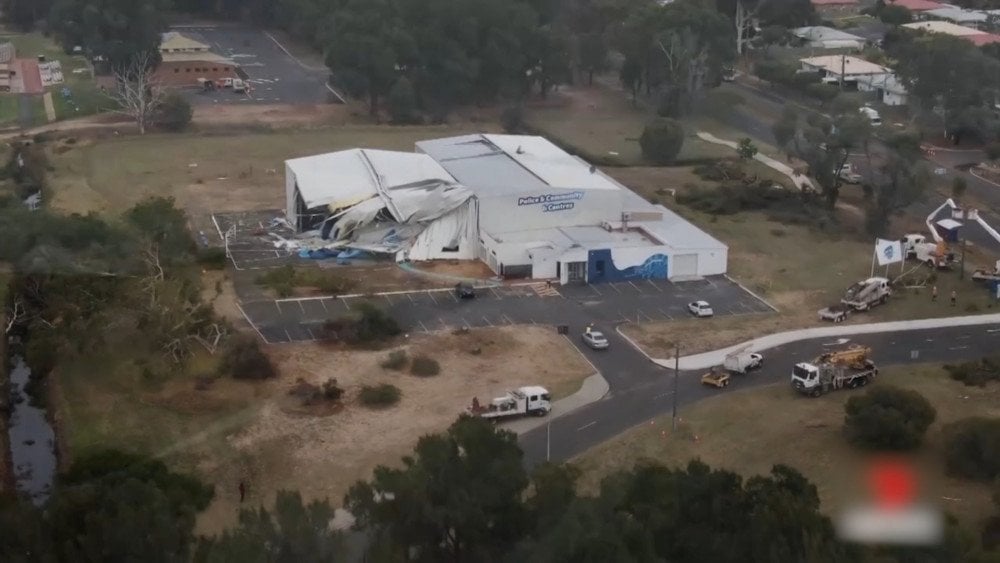
Aftermath of the Devastating Tornado in Bunbury, Australia
The tornado tore the building in half, causing the roof to collapse. Luckily, the children managed to escape to safety and were not harmed.
In total, about 40 buildings were damaged, and 6,000 homes were left without power.
South America
Brazil
Abnormal rains that began in late April almost completely submerged the state of Rio Grande do Sul in southern Brazil. Massive floods washed away roads, destroyed bridges, and caused landslides across the state.
The tragedy claimed the lives of 151 people, injured 806, and 104 are still missing.
The number of affected people has reached
over 2 million,
with more than 600,000 forced to leave their homes.

Unprecedented Flooding in Rio Grande do Sul, Brazil
The entire country is raising funds for food, clothing, and other essentials for the affected. Volunteers from other regions joined the search and rescue operations with their boats and kayaks.
The unprecedented climate disaster left entire cities underwater and destroyed critical infrastructure in the capital and rural areas. Thousands of livestock perished, and food storage facilities were damaged. The flood caught farmers off guard during the final stages of harvesting soybeans, rice, and wheat, threatening exports and causing significant damage to the national economy.
In early May, continuous rains caused the Jacuí, Caí, and Sinos rivers, which feed Lake Guaíba in Porto Alegre, the capital of Rio Grande do Sul, to overflow. Some parts of the city were completely flooded. Floodwaters engulfed the international airport and major stadiums, rendering highways impassable.
Several water treatment facilities ceased functioning,
leaving about 80% of the population without access to drinking water.
Many residents were left without electricity after power companies cut supplies for safety reasons.
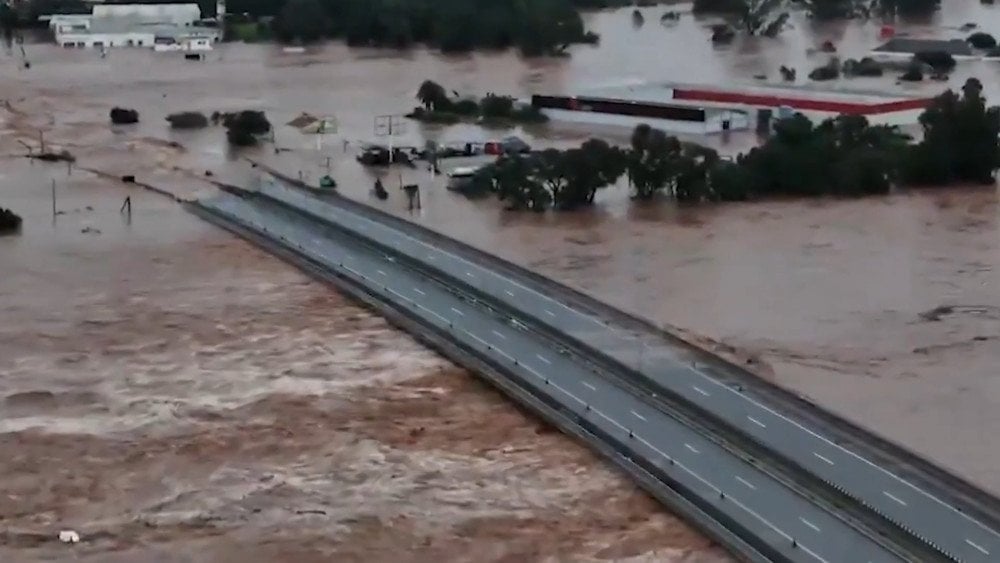
Part of the infrastructure in Rio Grande do Sul is completely flooded
This has already become
the largest flood in the city's history.
The 1941 record for the water level in Lake Guaíba (4.76 meters) was broken twice in less than two weeks. On May 5, the water level reached 5.33 meters (17.49 feet). After that, it began to decrease slowly, but on May 14, the Guaíba water level rose again to 5.20 meters (17.06 feet). The water poured into the city’s streets, forcing residents to evacuate their homes again. Cold weather worsened the situation for those affected by the flooding in Rio Grande do Sul.

Waters from Lake Guaíba overflowed and flooded surrounding areas
Pelotas, the fourth-largest city in Rio Grande do Sul, faced the worst flooding in 83 years. People had to be urgently evacuated.
Besides the catastrophic flood, residents of the Caxias do Sul municipality faced another danger. On the morning of May 13, they were awakened by underground tremors accompanied by what they described as an “explosion.” Many residents, frightened by the earthquakes, ran out into the streets in the middle of the night. The municipality of Gramado also experienced strong tremors, causing numerous landslides. New cracks were discovered on the federal highway BR-116.
Officials declared that the unprecedented rains and floods are “the worst natural calamity” to hit the state of Rio Grande do Sul.
Europe
Russia
In early May, a weather apocalypse hit almost the entire European part of the country.
The first ten days of the month became
the coldest on record,
with air temperatures 8–10 °C below the climate norm. Many meteorologists have already called this a prolonged anomaly.
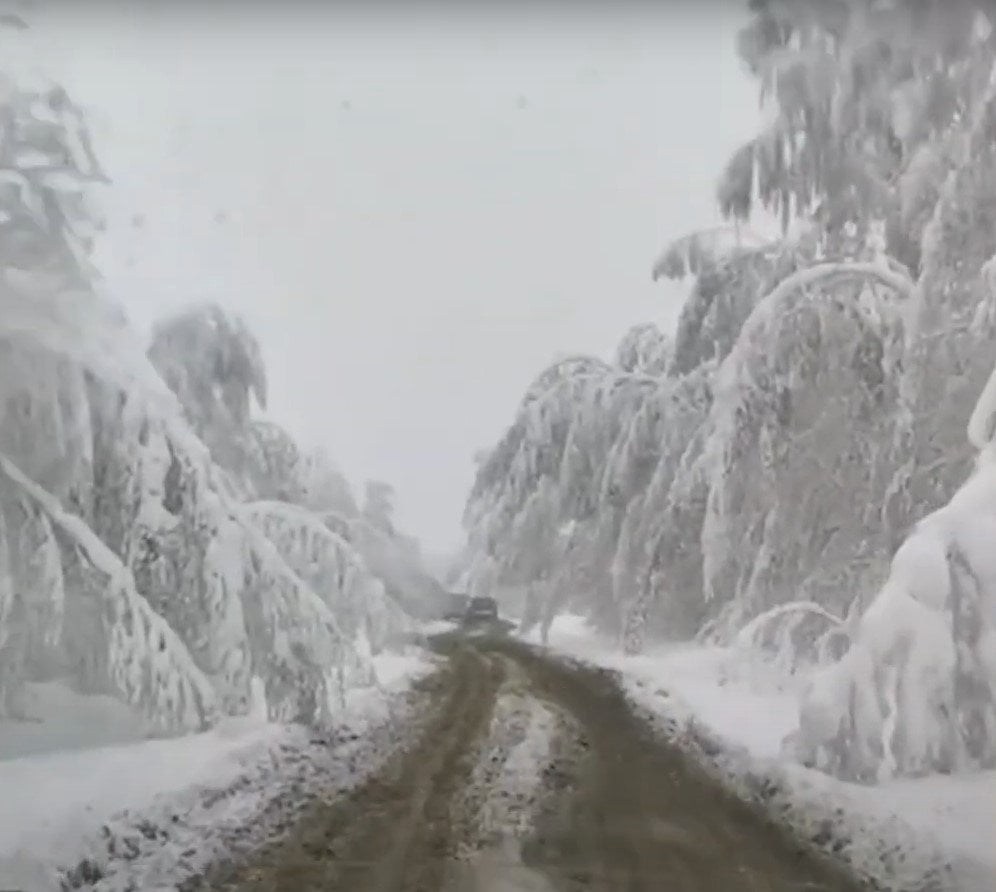
Abnormal Cold and Unseasonal Snowfall in May, Russia
From May 8 to 14, powerful snowfalls affected at least 20 regions of Russia. The weather anomaly suddenly covered Moscow, Sverdlovsk, Chelyabinsk, Kurgan, and Orenburg, and other regions.
On May 8, a record May snow cover of 12 cm (4.7 inches) blanketed Nizhny Novgorod.

May snow covered flowers in parks, Nizhny Novgorod, Russia
On May 11, snowdrifts in some areas of Udmurtia reached 8 cm (3.14 inches).
Local residents shared their impressions: “Driving this morning, it felt more like December than May. The roads, fields, and trees were all covered in snow,” “There were snow ruts on the roads! Incredible! It's the middle of May. I got stuck today. The roads are not plowed.” The most difficult situation arose in three regions: Tambov, Voronezh, and Lipetsk, where a state of emergency was declared.
In the Voronezh region, the cold destroyed crops of wheat, corn, beets, and other crops. More than 265,000 hectares of farmland were affected in the region. Frosts destroyed almost all major crops that had already sprouted. Even resilient winter wheat suffered damage over 100,000 hectares. This had never happened in the region before.
In the south of the country, the sudden temperature drop jeopardized part of the spring and vegetable crops. For example, in the Krasnodar Krai, frost damaged pea and potato plantings.
In the Volgograd region, grapes, apricots, cherries, and other stone fruits were lost.
Unexpected May frosts and snowfalls
damaged crops in 41 regions of the country:
Central Russia, the South of Russia, the Volga region, and the North Caucasus.

Crops damaged by sudden frosts, Russia
Air temperatures in the regions dropped to -10 °C, which is deadly for crops. Preliminary estimates suggest the area of crop losses amounted to 1.5 million hectares.
According to Bloomberg, frosts in the first half of May in Russia have already led to rising wheat prices on global markets.
Italy
The Campi Flegrei supervolcano is showing extremely alarming activity. A shocking increase in the number of earthquakes has been observed in the caldera area.
In April alone, 1,252 seismic events occured.
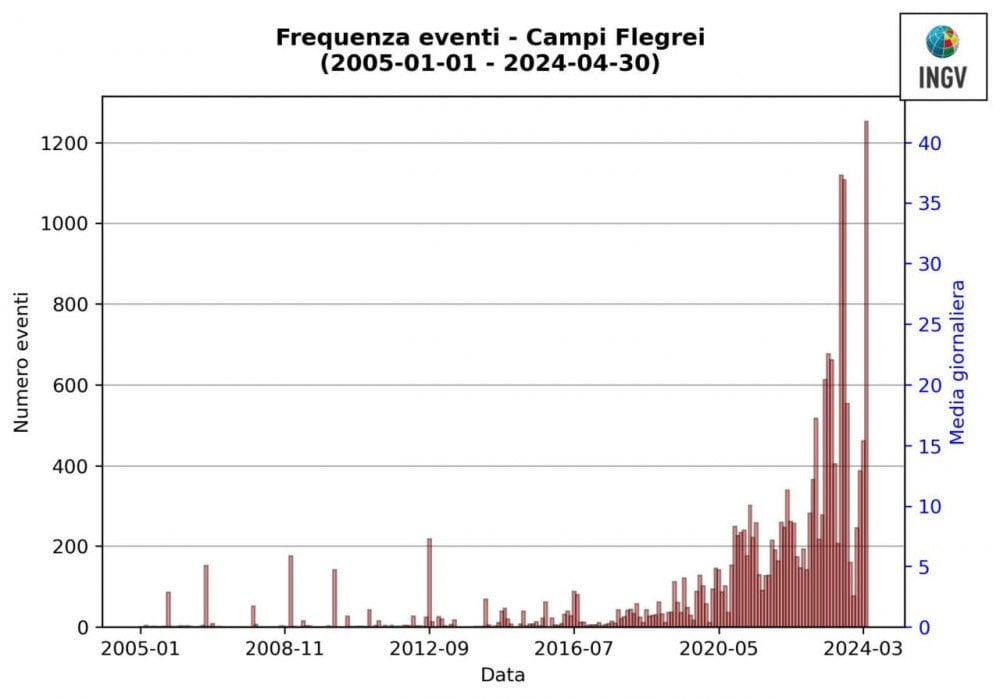
Exponential increase in earthquakes in the Campi Flegrei supervolcano area, Italy
On May 7, an abnormally prolonged earthquake swarm was recorded here: over 150 seismic events in 24 hours.
According to the National Institute of Geophysics and Volcanology (INGV), the strongest quake of 3.2 magnitude occurred near the city of Pozzuoli.
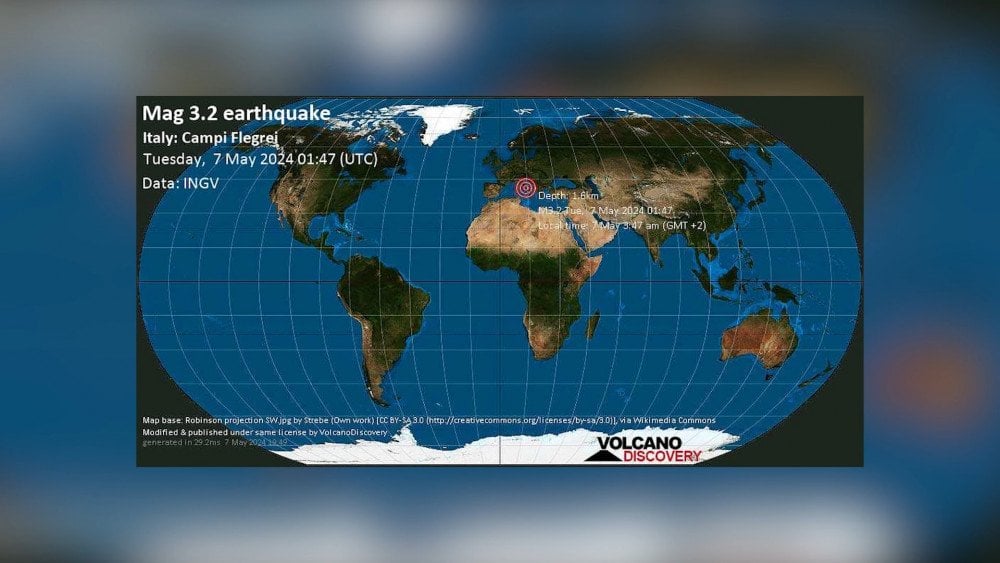
Earthquake M3.2 near Pozzuoli in the Campi Flegrei Caldera area, Italy
Earthquakes are an accompanying phenomenon of bradyseism, which indicates the rising and falling of the area above a magma reservoir due to volcanism.
Since 2005, the ground level has risen by 1.26 meters (4.13 feet).
This is 31.5 cm (12.4 in.) above the record of the 1980s,
when the town of Pozzuoli was evacuated due to fears of an impending volcanic eruption.
The rate of ground uplift in the Campi Flegrei area is a worrying factor.
According to the weekly bulletin of the National Institute of Geophysics and Volcanology,
the rate of uplift at the supervolcano has quadrupled and is rising faster than it has in recent decades.

Diagram of ground uplift in the Campi Flegrei Supervolcano area, Italy
Volcanologist Roberto Scandone, a retired professor of volcano physics at the Roma Tre University and a representative of the state commission on major risks, commented on the activation of the supervolcano: “...the ascent of magma can occur very quickly with very short seismic precursors within a few hours and precede an explosive eruption.” He added: “If I had resources, I would evacuate the Phlegraean Fields.”
Half a million residents living close to the supervolcano are extremely frightened. Authorities are conducting emergency evacuation drills in the city.
Solar Flares
Previously, to see the aurora, people had to travel to polar regions, but on the night of May 11 and in the following days, bright and prolonged auroras could be observed from your window at home on all continents.

G5 class geomagnetic storm caused abnormal auroras worldwide
The reason for this abnormal phenomenon was the strongest X-class solar flares. They triggered a powerful geomagnetic storm of the highest, fifth class—G5.
It is important to note that in May alone, over 14 days, 98 M-class flares and 17 X-class flares occurred on the Sun. This indicates extreme solar activity. The geomagnetic storm on May 11 became the most powerful of the 21st century!
The impact of the solar flare on our planet's magnetosphere was so strong that besides disrupting shortwave radio communication it also caused malfunctions in StarLink satellites.

The strongest geomagnetic storm of the 21st century
The Earth's magnetic field is critically weakening, reducing the planet's protection from cosmic radiation. Therefore, during a powerful geomagnetic storm, auroras moved extremely close to the equator. If usually observed in the region of 67–70° north or south latitudes, very close to the poles, this time auroras were recorded in Namibia (23° S), the Canary Islands (28° N), and other regions very close to the equator.
Social media was flooded with photos and videos of people against the backdrop of auroras in pink, red, purple, and other unusual shades.
This seemingly beautiful phenomenon signals great danger. Aurora anomalies indicate that the Earth's magnetic field is critically weakening, the atmosphere is contracting, and the solar wind is getting closer and closer down to the surface. Severe disturbances in the magnetic field suggest that the core of our planet has ceased to function as it used to.
A year ago, at the “Global Crisis. There Is a Way Out” forum, scientists warned of this serious threat and predicted that such abnormal red auroras would become more frequent.
Why such global changes are happening on our planet and how we can prevent the impending threat was discussed at the International Forum “Global Crisis. The Responsibility.”
You can watch the video version of this article here:
Leave a comment